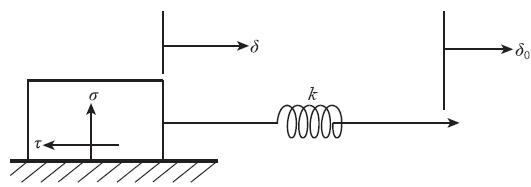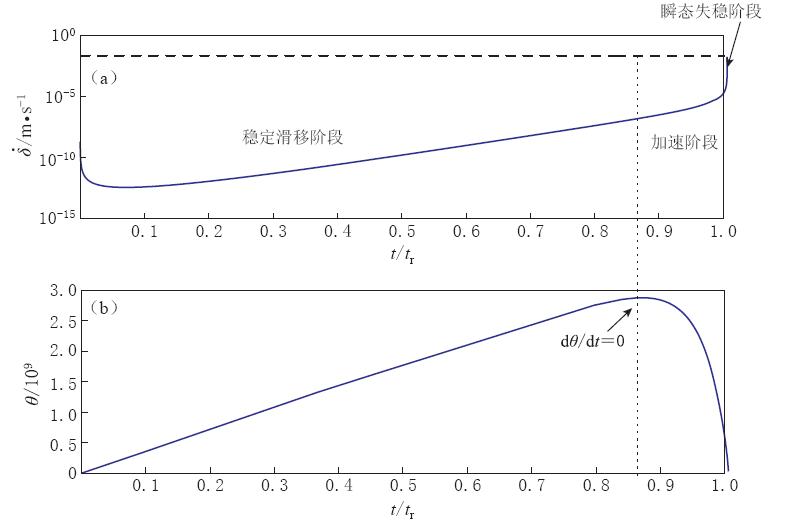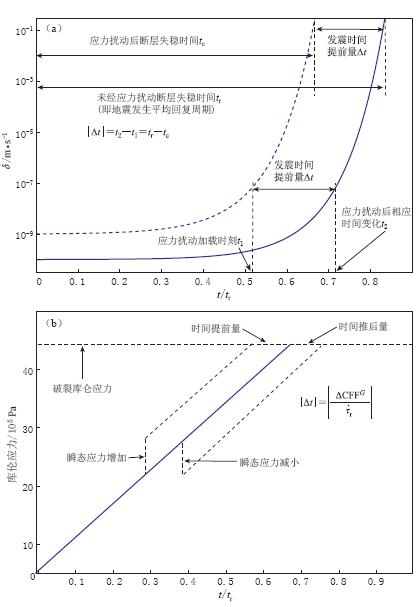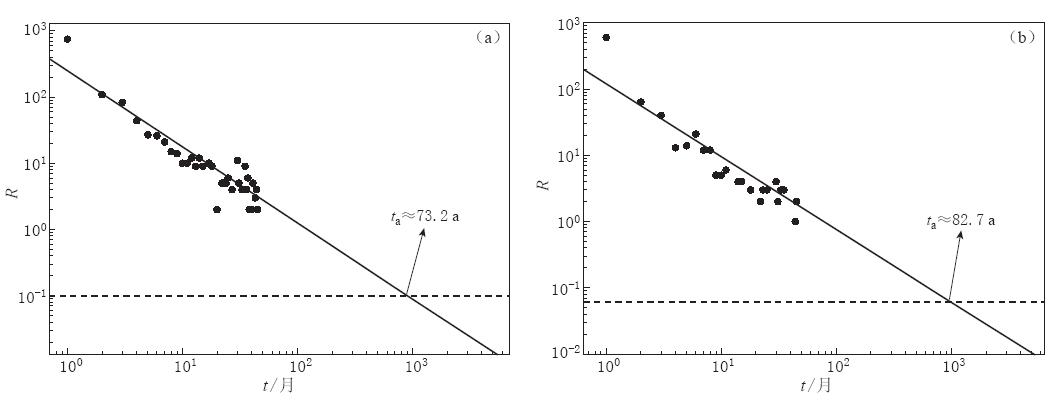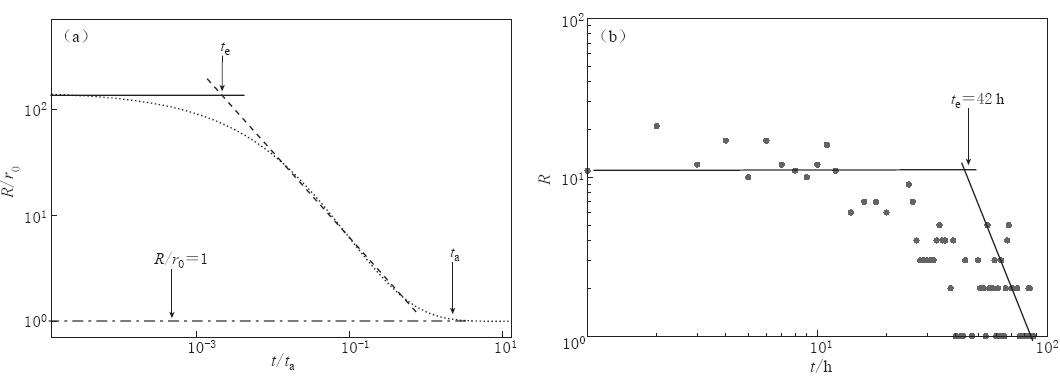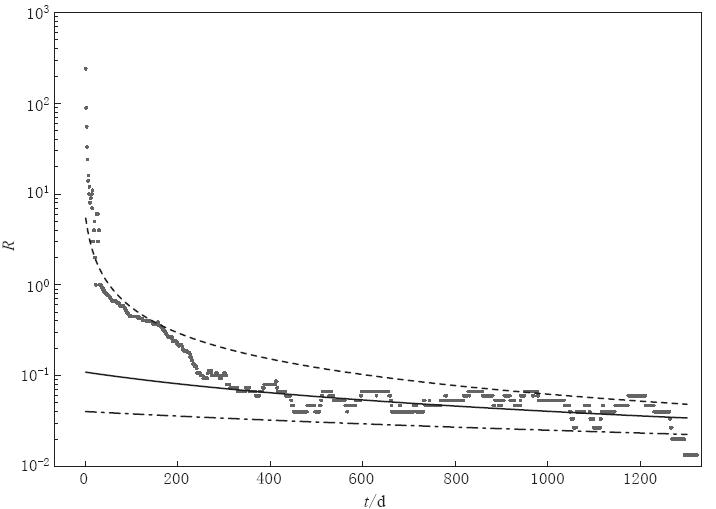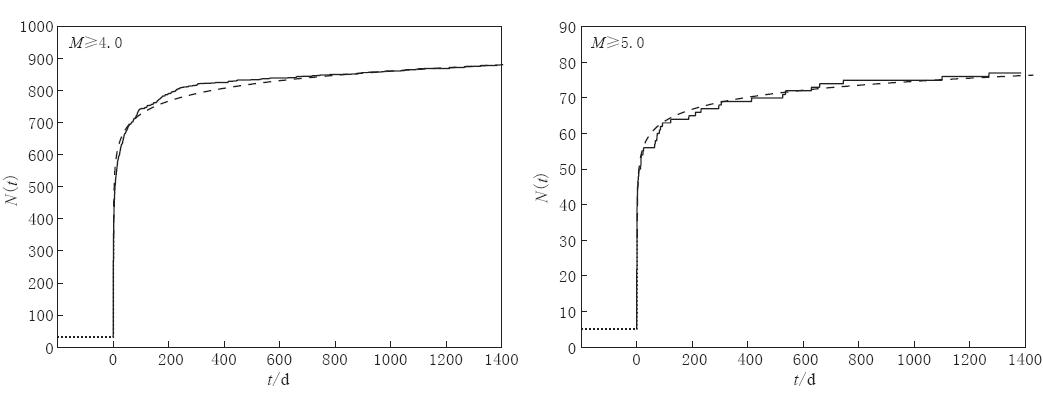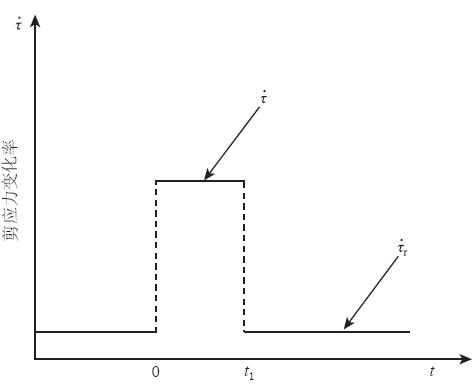Triggering mechanism of aftershocks triggered by Wenchuan MW7.9 earthquake
-
摘要: 余震触发机制的Dieterich解析模型被广泛应用于区域地震活动性的定量分析以及依赖时间的概率地震预测模型的建立等方面. 基于滑移速率和状态相依赖的摩擦定律和弹簧-滑块模型, 从Dieterich断层滑移速率方程出发, 给出了静态应力扰动下触发地震的时钟提前或推后的近似解, 从而明确地阐明了触发地震的产生机制与断层的演化过程密切相关, 并与传统位错模型下库仑应力扰动时间提前或推后量作了比较. 采用对数线性拟合方法求得了汶川MW7.9主震后余震序列持续时间, 符合Dieterich理论结果. 以汶川余震序列为例, 给出了两种不同的应力扰动模式在该余震序列中的应用. 结果表明, 经典Dieterich扰动解无法给出主震发生后即时余震数量的异常增加, 而考虑主震前后剪应力速率变化的Dieterich分段解则可反映出余震发生率及个数随时间的演化特征.Abstract: The analytic solution of earthquake triggering mechanism put forward by Dieterich has been widely used in quantitative analysis and description of regional seismic activities, and in the development of time-dependent earthquake prediction model. Based on the spring-slider model with a combination of rate-and-state-dependent friction, starting from the fault slip rate evolution equation proposed by Dieterich, we have derived the equation called clock advance/delay related to the earthquake faulting instability under the Coulomb stress perturbation. In comparison with the simple dislocation model, the current result suggests that the generation of earthquakes is actually related to the state of fault evolution. For the 2008 Wenchuan MW7.9 earthquake sequence, we have estimated the possible time duration of aftershocks caused by main shock, both from theoretical inferring and empirical relation, and the result is similar to each other. Furthermore, two different stress change models have been used in the calculations of aftershock’s seismicity rate and cumulative number. These results suggest that the classic Dieterich stress change model could not fit the anomalous event increase well during a very short initial phase after the main shock, while the modified Dieterich model, which concerns the temporal variation of the fault shear stress rate, could be used to quantitatively describe the temporal evolution of aftershock decay.
-
Keywords:
- Wenchuanearthquake /
- stressperturbation /
- aftershock /
- duration /
- clockadvance/delay
-
-
图 2 单自由度的弹簧-滑块模型σ和τ分别为断层上加载的正应力和剪切应力,δ0(t)为远场加载位移, δ(t)为滑块自身的滑动位移, k为弹簧的有效弹性系数
Figure 2. A simple spring-slide block modelσ and τ are normal and shear stress loaded applied on the slide block, respectively. δ0(t) is the remote loading displacement, and δ(t) is the slider’s slip displacement. k is an effective spring stiffness
图 3 由单自由度弹簧-滑块模型得到的断层演化全过程示意图(a)地震周期中断层滑移速率的演化过程;(b)地震周期中断层状态变量的演化过程
Figure 3. Temporal evolution of a typical seismic cycle derived from one dimensional spring-block model. (a) Temporal evoluation of fault slip rate during a full seismic cycle; (b) Temporal evoluation of fault state variation during a full seismic cycle
图 4 断层受应力扰动时时钟提前(推迟)示意图(a) Dieterich模型得到的受应力扰动时断层发震的提前(推迟)时间变化量示意图;(b) 传统库仑位错模型给出的受应力扰动时断层发震的提前(推迟)时间变化量示意图
Figure 4. Clock advance/delay due to static stress perturbation loaded on the fault(a) Clock advance/delay derive from Dieterich model due to static stress perturbation; (b) Clock advance/delay derive from Coulomb dislocation model due to static stress perturbation
图 5 汶川地震后单位时间(月)内M≥3.5 (a)和M≥4.0 (b)余震发生率随时间衰减关系圆点是实际地震数据统计得到的地震发生率, 实线是用对数线性拟合得到的地震发生率,虚线为背景场地震发生率
Figure 5. (a) The decay of M≥3.5 aftershock seismicty rate by month; (b) The decay of M≥4.0 aftershock seismicty rate by month. Black dots represent the observed aftershock seismicty rate from the Wenchuan mainshock. Solid line denotes the result of log-log regression. The background seismicity rate is shown as the dashed line
图 6 te定义的示意图. 其中点线为公式(14)给出的主震后地震发生率随时间衰减关系,点划线为背景场地震发生率, 虚线为R(Δτ→∞), 实线为R(t1);(b) 汶川主震后100小时内地震发生率随时间衰减变化示意图
Figure 6. (a) The definition of te. Dotted line represents the aftershocks seismicity rate variation with time given by equation (14). Dotted line represents background seismicity rate. The dashed line and solid line represent R(Δτ→∞) and R(t1) respectively; (b) Seismicity rate variations with time during the first 100 hours after the Wenchuan main shock
图 7 2008年汶川MW7.9地震主震后余震发生率随时间变化. 图中点为由观测得到的M≥4.0的地震发生率, 虚线、 实线和点划线分别给出了当ΔCFFG=0.4, 0.2和0.15 MPa时余震发生率随时间衰减的过程. 在计算中,aσ=0.05 MPa, ta=85 a, r0=0.75次/a
Figure 7. The decay of aftershock seismicity rate following Wenchuan MW7.9 mainshock. The observed seismicity rate of earthquakes (M≥4.0) is plotted as dots. Dashed, solid and dotted lines are plotted from equation (14) with ΔCFFG=0.4, 0.2 and 0.15 MPa respectively. In the computation, aσ=0.05 MPa, ta=85 a, r0=0.75/a
图 8 汶川MW7.9地震主震后余震M≥4.0(a)和M≥5.0 (b)累积次数N随时间变化.图中实线为背景场地震累积次数, 虚线为观测得到的主震后地震累积次数, 点线为应用公式(15)计算得到的地震累积次数. 在计算中点线取aσ=0.05 MPa, ta=85 a,ΔCFFG=0.2 MPa, M≥4.0和M≥5.0背景地震发生率分别取0.75次/a和0.073次/a
Figure 8. The cumulative number, N, of aftershocks with M≥4.0 (a) and M≥5.0 (b) following Wenchuan MW7.9 mainshock. The cumulative number of background earthquake is shown as the solid line. The observed data of aftershocks are plotted as the dashed line. Earthquake cumulative number denoted by dotted line is plotted from equation (15) with ΔCFFG=0.2 MPa, aσ=0.05 MPa, ta=85 a,r0=0.75/a for M≥4.0 and r0=0.073/a for M≥5.0
图 9
This page contains the following errors:
error on line 1 at column 1: Start tag expected, '<' not foundBelow is a rendering of the page up to the first error.
Figure 9.
This page contains the following errors:
error on line 1 at column 1: Start tag expected, '<' not foundBelow is a rendering of the page up to the first error.
图 10
This page contains the following errors:
error on line 1 at column 1: Start tag expected, '<' not foundBelow is a rendering of the page up to the first error.
Figure 10.
This page contains the following errors:
error on line 1 at column 1: Start tag expected, '<' not foundBelow is a rendering of the page up to the first error.
-
陈连旺, 张培震, 陆远忠, 陈化然, 马宏生, 李丽, 李红. 2008. 川滇地区强震序列库仑破裂应力加卸载效应的数值模拟[J]. 地球物理学报, 51(5): 1411-1421. 陈学忠, 李艳娥, 郭祥云. 2008. 2008年5月12日四川汶川8.0级地震前后震源区应力水平估计[J]. 国际地震动态, (6): 1-3. 郭啟良, 王成虎, 马洪生, 王崇艮. 2009. 汶川 MS8.0级大震前后的水压致裂原地应力测量[J]. 地球物理学报, 52(5): 1395-1401. 华卫, 陈章立, 李志雄, 赵翠萍, 王勤彩. 2009. 汶川8.0级地震触发与余震活动空间分布研究[J]. 地震, 29(1): 33-39. 焦青, 杨选辉, 许丽卿, 王博. 2008. 汶川8.0级地震前后龙门山断裂活动特征浅析[J]. 大地测量与地球动力学, 28(4): 7-11. 刘博研, 史保平. 2012. MS8.1昆仑山口西地震和MS8.0汶川地震余震序列的时空分布特征和持续时间的对比[J]. 地球物理学报, 55(6): 1942-1951. 单斌, 熊熊, 郑勇, 刁法启. 2009. 2008年5月12日MW7.9汶川地震导致的周边断层应力变化[J]. 中国科学: D辑, 39(5): 537-545. 孙莉. 2010. 四川地区历史地震活动性分析[D]. 北京: 中国地质大学(北京): 55-57. 田勤俭, 刁桂苓, 郝平, 冯向东, 孙晴. 2009. 汶川8.0级地震及余震破裂的地质构造特征[J]. 地震, 29(1): 141-148. 万永革, 沈正康, 盛书中, 徐晓枫. 2009. 2008 年汶川大地震对周围断层的影响[J]. 地震学报, 31(2): 128-139. 王卫民, 赵连锋, 李娟, 姚振兴. 2008. 四川汶川8.0 级地震震源过程[J]. 地球物理学报, 51(5): 1403-1410. 解朝娣, 朱元清, 于海英, 虎雄林. 2010. MS8.0汶川地震产生的应力变化空间分布及其对地震活动性的影响[J]. 中国科学: 地球科学, 40(6): 688-698. 张培震, 徐锡伟, 闻学泽. 2008. 2008年汶川8.0级地震发震断裂的滑动速率、 复发周期和构造成因[J]. 地球物理学报, 51(4): 1066-1073. 张勇, 冯万鹏, 许力生, 周成虎, 陈运泰. 2008. 2008年汶川大地震的时空破裂过程[J]. 中国科学: D辑, 38(10): 1186-1194. 张致伟, 程万正, 阮祥, 吴朋. 2009. 汶川8.0级地震前龙门山断裂带的地震活动性和构造应力场特征[J]. 地震学报, 31(2): 117-127. Dieterich J H. 1994. A constitutive law for rate of earthquake production and its application to earthquake clustering[J]. J Geophys Res, 99(B2): 2601-2618.
Dieterich J H. 1979. Modeling of rock friction [J]. J Geophys Res, 84(B5): 2161-2168.
Dieterich J H. 1992. Earthquake nucleation on faults with rate and state-dependent strength[J]. Tectonophysics, 211(1-4): 115-134.
Dieterich J H, Kilgore B. 1996. Implications of fault constitutive properties for earthquake prediction[J]. Proceedings of the National Academy of Sciences, 93(9): 3787-3794.
Freed A M. 2005. Earthquake triggering by static, dynamic and postseismic stress transfer[J]. Annu Rev Earth Planet Sci, 33: 335-367.
Gomberg J, Belardinelli M E, Cocco M, Reasenberg P. 2005. Time-dependent earthquake probabilities[J]. J Geophys Res, 110(B5): B05S04.
Hardebeck J L. 2004. Stress triggering and earthquake probability estimates[J]. J Geophys Res, 109(B4): B04310.
Harris R A. 1998. Introduction to special section: Stress triggers, stress shadows, and implications for seismic hazard[J]. J Geophys Res, 103(B10): 24347-24324, 24358.
Harris R A, Simpson R W. 1992. Changes in static stress on southern California faults after the 1992 Landers earthquake[J]. Nature, 360: 251-254
King G C P, Stein R S, Lin J. 1994. Static stress changes and the triggering of earthquakes[J]. Bull Seism Soc Amer, 84(3): 935-953.
Omori, Fusakichi. 1894. On the after-shocks of earthquakes[J]. The Journal of the College of Science, Imperial University, 7(2): 111-200.
Parsons T. 2005. Significance of stress transfer in time-dependent earthquake probability calculations[J]. J Geophys Res, 110(B5): B05S02.
Parsons T, Ji C, Kirby E. 2008. Stress changes from the 2008 Wenchuan earthquake and increased hazard in the Sichuan basin[J]. Nature, 454(7203): 509-510.
Parsons T, Toda S, Stein R S, Barka A, Dieterich J H. 2000. Heightened odds of large earthquakes near Istanbul: An interaction-based probability calculation[J]. Science, 288(5466): 661-665.
Ruina A. 1983. Slip instability and state variable friction laws[J]. J Geophys Res, 88(B12): 10359-10370.
Segall P, Desmarais E K, Shelly D, Miklius A, Cervelli P. 2006. Earthquakes triggered by silent slip events on Kilauea volcano, Hawaii[J]. Nature, 442(7098): 71-74.
Steacy S, Gomberg J, Cocco M. 2005. Introduction to special section: Stress transfer, earthquake triggering, and time-dependent seismic hazard[J]. Journal of Geophysical Research-Solid Earth, 110(B5): B05S01.
Stein R S, Barka A A, Dieterich J H. 1997. Progressive failure on the North Anatolian fault since 1939 by earthquake stress triggering[J]. Geophys J Inter, 128(3): 594-604.
Toda S, Lin J, Meghraoui M, Stein R S. 2008. 12 May 2008 M=7.9 Wenchuan, China, earthquake calculated to increase failure stress and seismicity rate on three major fault systems[J]. Geophys Res Lett, 35(17): L17305.
Toda S, Stein R S, Reasenberga P A, Dieterich J H, Yoshida A. 1998. Stress transferred by the 1995 MW 6.9 Kobe, Japan, shock: Effect on aftershocks and future earthquake probabilities[J]. J Geophys Res, 103(24): 543-565.
Utsu T. 1961. A statistical study on the occurrence of aftershocks[J]. Geophys Mag, 30(4): 526-605.
Zhu H, Wen X. 2010. Static stress triggering effects related with MS8.0 Wenchuan earthquake[J]. Journal of Earth Science, 21(1): 32-41.
-
期刊类型引用(5)
1. Mengyu Xie,Baoping Shi,Lingyuan Meng. Transient postseismic slip and aftershock triggering: A case study of the 2008 M_W7.9 Wenchuan Earthquake, China. Earthquake Science. 2023(06): 445-457 .  必应学术
必应学术
2. 解孟雨,史保平,林禄春. 自维持断层蠕滑过程和余震发生率的衰减特征——以汶川M_W7.9地震序列为例. 地震学报. 2018(03): 316-331 .  本站查看
本站查看
3. Song Jin,Jiang Haikun,Meng Lingyuan,Zang Yang. Earthquake Probability of the “Seismic Gap” on the Longmenshan Fault. Earthquake Research in China. 2018(01): 15-27 .  必应学术
必应学术
4. 宋金,蒋海昆,孟令媛,臧阳. 龙门山断裂带上“破裂空段”的发震概率研究. 中国地震. 2017(02): 219-228 .  百度学术
百度学术
5. 刘博研,史保平. 汶川地震同震过程中断层间的相互作用及子事件触发. 地震地质. 2015(02): 357-373 .  百度学术
百度学术
其他类型引用(1)





 下载:
下载:
